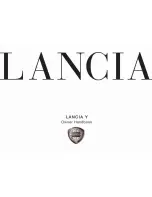
Tyre pressures
G
Risk of accident
Tyre pressure that is either too high or too
low has a negative effect on the vehicle
’
s
active safety, which could lead to you caus-
ing an accident. You should therefore regu-
larly check the pressure of all your tyres (in-
cluding the spare tyre*), particularly prior to
long trips, and correct the pressure as nec-
essary.
To test tyre pressure, use a suitable pres-
sure gauge. The outer appearance of a tyre
does not permit any reliable conclusion
about the tyre pressure.
If the vehicle is to be heavily laden or driv-
en at high speeds, the tyre pressure must
be adapted according to the specifications
given in the fuel filler flap (
e
page 193).
Use the highest specified tyre pressure for
the spare wheel.
G
Risk of accident
If a tyre's pressure drops repeatedly:
I
inspect the tyre for foreign objects
I
check whether the tyre is punctured or
the valve is leaking.
Tyre pressure changes by approximately
0.1 bar for every 10 °C change in ambient
temperature.
If you measure the tyre pressure indoors
where the temperature differs from the
outside temperature, you will have to cor-
rect the measured value accordingly.
When the vehicle is driven, the tyre tem-
perature, and with it the tyre pressure, will
increase depending on the road speed and
the load on the tyres.
Therefore, you should only correct tyre
pressures when the tyres are cold.
The pressure of warm tyres should only be
corrected if it is too low for the current op-
erating conditions. Warm tyres always
have higher pressures than cold tyres.
You will find a table of tyre pressures for
various operating conditions on the inside
of your vehicle's fuel filler flap.
Driving with tyre pressure that is too high
or too low:
I
shortens the service life of the tyres
I
causes increased tyre damage
I
has a negative effect on handling char-
acteristics and thus driving safety as
well (e.g. by causing aquaplaning).
i
The tyre pressure values given for low
loads are minimum values which offer you good
ride comfort characteristics.
You can, however, also use the values given for
higher loads. These are permissible and will not
adversely affect the running of the vehicle.
However, ride comfort will be impaired to some
degree.
Also check the tyre pressure of the spare
wheel*.
H
Environmental note
Check tyre pressures regularly, at least
every two weeks.
Tyre pressure loss warning system
While the vehicle is in motion, the tyre
pressure loss warning system monitors
the set tyre pressure using the rotational
speed of the wheels. This enables the sys-
tem to detect significant pressure loss in a
tyre. If the speed of rotation of a wheel
changes as a result of a loss of pressure, a
corresponding warning message will ap-
pear in the multi-function display.
The function of the tyre pressure loss
warning system is limited or delayed if:
Operation
Tyres and wheels
203
ee
Nur fuer internen Gebrauch
Nur fuer internen Gebrauch
Summary of Contents for 280 C
Page 1: ...Owner s Manual C Class Nur fuer internen Gebrauch Nur fuer internen Gebrauch...
Page 46: ...44 Nur fuer internen Gebrauch Nur fuer internen Gebrauch...
Page 76: ...74 Nur fuer internen Gebrauch Nur fuer internen Gebrauch...
Page 163: ...Controls Thermatic 161 Nur fuer internen Gebrauch Nur fuer internen Gebrauch...
Page 192: ...190 Nur fuer internen Gebrauch Nur fuer internen Gebrauch...
Page 222: ...220 Nur fuer internen Gebrauch Nur fuer internen Gebrauch...
Page 312: ...310 Nur fuer internen Gebrauch Nur fuer internen Gebrauch...
















































